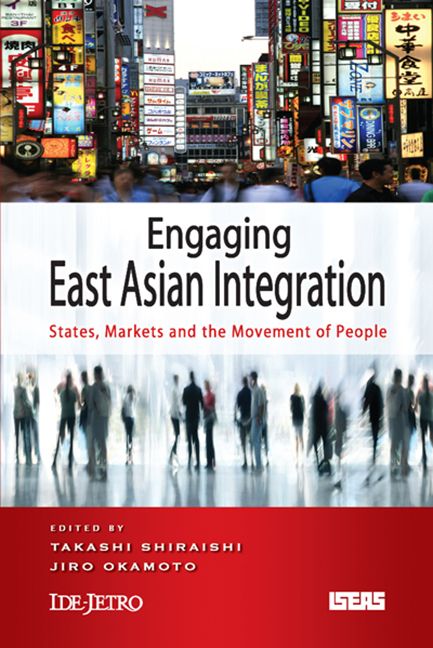Book contents
- Frontmatter
- Contents
- Foreword
- List of Figures and Tables
- Contributors
- 1 Introduction
- Part I EVOLUTION OF EAST ASIAN INTEGRATION
- Part II STATES, MARKETS AND THE MOVEMENT OF PEOPLE
- 4 Economic Integration in East Asia and Japan's Strategy
- 5 The Nature of East Asian Integration and Australia's Engagement
- 6 The Migration of Professionals in an Integrating East Asia
- 7 Panel Discussion
- Index
4 - Economic Integration in East Asia and Japan's Strategy
from Part II - STATES, MARKETS AND THE MOVEMENT OF PEOPLE
Published online by Cambridge University Press: 21 October 2015
- Frontmatter
- Contents
- Foreword
- List of Figures and Tables
- Contributors
- 1 Introduction
- Part I EVOLUTION OF EAST ASIAN INTEGRATION
- Part II STATES, MARKETS AND THE MOVEMENT OF PEOPLE
- 4 Economic Integration in East Asia and Japan's Strategy
- 5 The Nature of East Asian Integration and Australia's Engagement
- 6 The Migration of Professionals in an Integrating East Asia
- 7 Panel Discussion
- Index
Summary
INTRODUCTION
Triggered by the bankruptcy of the investment banking giant Lehman Brothers, the financial crisis that originated in the United States instantly spreaded across the global economy. There was a string of bailouts of troubled financial institutions not only in the United States, but also in Europe, and the global recession deepened at a pace not seen since World War II, as symbolized by the simultaneous decline of world stock markets and the struggling Big Three. There were signs of a slowdown in the real economy of East Asia as well. However, the impact of the crisis was slighter in this region than among Western countries, so expectations for East Asia to drive the growth of the global economy grew ever more.
In this chapter, I provide an overview of the current situation of East Asia, the world's growth centre, where economic integration is under way, and present an analysis of the impact of FTAs — which are being rapidly put into effect in recent years — on trade within the East Asia region. I then consider the challenges Japan should take on to promote the integration of the East Asian economy further and ensure sustainable growth.
THE GROWING ASIAN MARKET AND ONGOING ECONOMIC INTEGRATION
Asia, the World's Growth Centre
The East Asian economy (Asian NIEs, ASEAN, and China) has been growing at a rate of around 8 to 9 per cent for the past few years. This is almost double the world's average growth rate, which explains why the region is called the “world's growth centre”. The contribution ratio of the East Asian economy (including India) to the world economy reached 40.3 per cent in 2007 (see Table 4.1).
In addition, Australia and New Zealand have been strengthening their economic relationships with East Asia in recent years. Adding Japan, India, Australia, and New Zealand to East Asia results in a huge business block with a population of about 3.2 billion and a total GDP of US$10 trillion.
Affected by the financial crisis in the United States, the East Asian economy faced the inevitable slowdown in 2009. But although the IMF forecasted that developed countries as a whole were going to slip into negative growth for the first time since World War II, Developing Asia (China, India and ASEAN-5) was nevertheless expected to grow at 4.8 per cent.
- Type
- Chapter
- Information
- Engaging East Asian IntegrationStates, Markets and the Movement of People, pp. 97 - 126Publisher: ISEAS–Yusof Ishak InstitutePrint publication year: 2012



